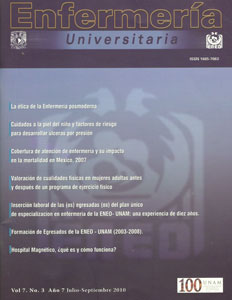Insertion of the (old) graduates (i) the plan of speciallization in nursing only Eneo-UNAM: a ten years experience
Main Article Content
Abstract
The objective of this research is to analyze the employment placing process of 12 generations from the ENEO UNAM’s Nursing Specialization Unique Plan.
Methodology: Basic descriptive study on a sample from the 1997-2008 generations’ 1,067 total graduates. Results: Findings show that 85% and 7% are employed by the Federal District and State of Mexico respectively. Nine out of ten graduates are employed by the country’s principal public institutions (62% in open-population institutions and 29% in social security institutions). 28% are employed as specialist nurses, and 20% assume roles with more responsibilities. 68% perform activities related to the direct management of patients, 21% have administrative duties, and only 1.2% is fully engaged in research.
Discussion: Considering the results, and that graduates hold better labor positions; and in order to promote post-graduate- studies completion, education institutions should keep improving their post-graduate programs and also support their links with the shifting labor markets.
Conclusion: It is necessary to strengthen the strategies which promote the synergies that contribute to the presence of the ENEO UNAM’s Nursing Specialization Unique Plan graduates in the Nursing profession and labor markets.
Publication Facts
Reviewer profiles N/A
Author statements
- Academic society
- N/A
- Publisher
- Universidad Nacional Autónoma de México
Article Details
Dimensions citation
MÉTRICAS

This work is licensed under a Creative Commons Attribution-NonCommercial-NoDerivatives 4.0 International License.
Enfermería Universitaria by Universidad Nacional Autónoma de México it is distributed under the License Creative Commons Attribution - NonCommercial - NoDerivatives 4.0 International
Accepted and published articles become open-access under the terms of the Creative Commons CC BY-NC-ND 4.0 license, which authorizes the reproduction and sharing without commercial purposes, provided the corresponding acknowledgments to their authors. Authors are allowed to manage a self-archive copy of the article’s published version so that they can open-access it in their personal or institutional web pages, and/or any other broad-diffusion space.



